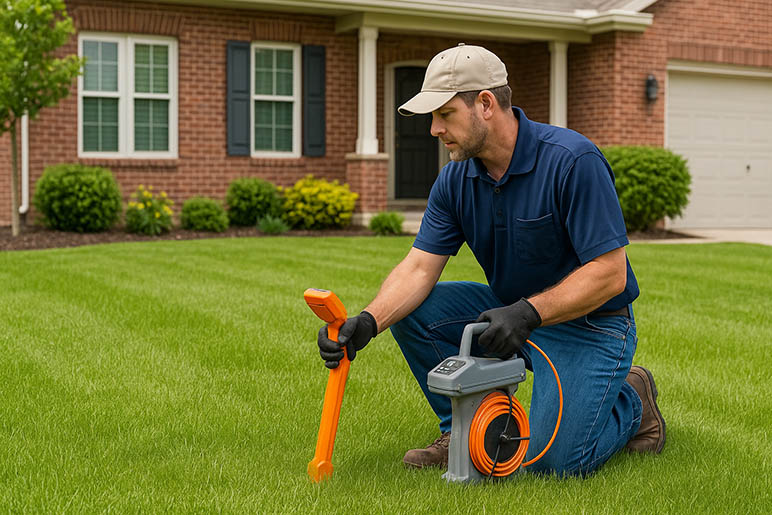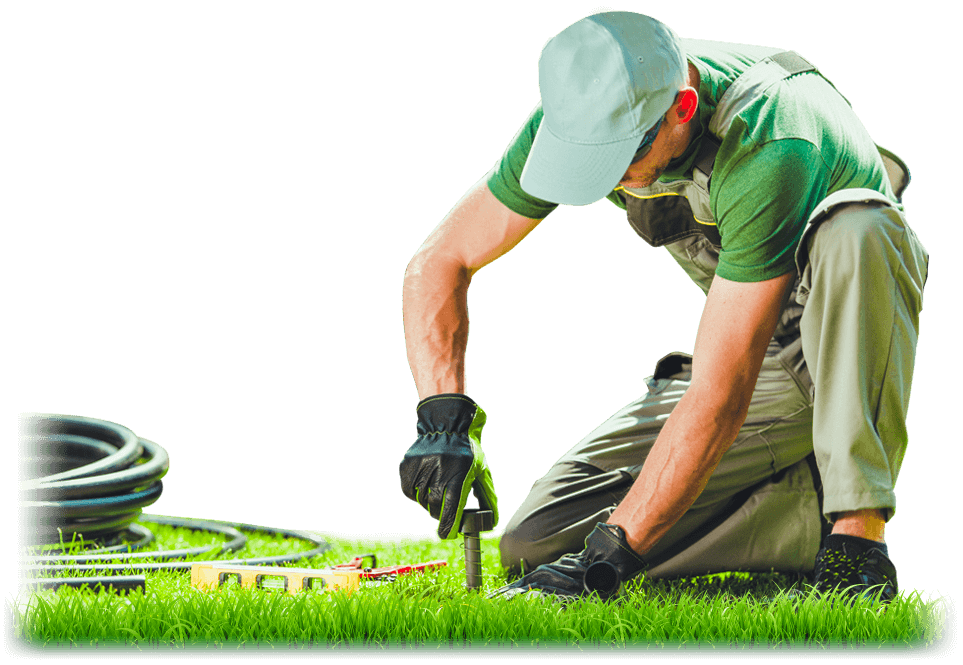
CS Sprinklers
Hire A Professional Sprinkler Company
When you hire a professional sprinkler company, you’re getting a hassle-free lawn ready for summer.
Trying to find your sprinkler lines without a shovel? Learn simple, smart ways to locate them without damaging your lawn or system.
If you’ve ever found yourself squinting at your lawn, garden hose in one hand and a shovel in the other, wondering where the heck those sprinkler pipes are hiding, you’re not alone. At CS Sprinklers, we get calls like this all the time. Denver residents trying to install a new fence, plant a tree, or undertake a backyard project don’t want to accidentally break a water line. Totally understandable. The good news is, with a bit of know-how and some easy tools, you can figure out where your sprinkler lines are without turning your lawn into a war zone.
Most sprinkler systems follow a pretty logical layout. Your main supply line usually starts at the backflow preventer or a valve box near the house. From there, it branches out to different zones across your yard. Each zone typically connects to several sprinkler heads laid out in patterns that ensure full coverage—meaning the lines usually run in straight lines between those heads. If you’ve got a rough idea of where the sprinkler heads are, you’ve already got a solid clue about where the lines might be hiding underground.
Start by walking your lawn and spotting every sprinkler head. These are the little pop-up guys you probably ignore until your foot finds one at the wrong time. Once you’ve found them all, try to imagine a straight line from one to the next. That’s often where the pipe runs. You can use flags, stakes, or even paint to mark a temporary path across your grass. It won’t be perfect, but it gives you a solid visual of your sprinkler layout—and avoids guesswork if you’re planning to dig nearby for any reason.
Now, if your system is older or the heads aren’t visible anymore—maybe they’ve been buried over time by soil, mulch, or grass clippings—you’ll need a little more help. One trick is to turn the system on zone by zone and watch where the heads pop up. That gives you a fresh visual of each spray pattern and can help you draw lines across the lawn to where the underground pipes run. If some heads don’t rise, take a thin screwdriver or flagging rod and gently probe around where they should be. If you feel something solid a few inches down, then you’ve likely hit a pipe or head.
If you’re looking for something a little more precise—or your system’s more complex than average—you might want to use a wire tracer or valve locator. These tools are handy little devices that send a signal through the system’s control wires, which usually run along the same paths as the pipes. You hook the transmitter to your controller or valve wire, then walk the yard with the receiver and listen for the beeping or buzzing that gets louder as you approach the buried line. We use these in the field all the time when a zone won’t fire, and we need to know where everything is without tearing up the property.
Sometimes people ask if metal detectors work. Not usually, unless your system has metal pipes, which is extremely rare, or if you’re just trying to find the valve box lid or backflow preventer. Most sprinkler lines are made from PVC or poly pipe, and metal detectors won’t pick them up. That’s why wire tracing is more effective since almost every system has a wiring path that runs from the controller to each valve. That path gives you the breadcrumbs you need to follow the layout.
Another way to map your sprinkler lines is by using your system’s controller. Each zone on the controller usually connects to a solenoid valve underground. These valves open and close to control water flow. You can manually activate one zone at a time from the controller and then listen for water movement or pressurization. Sometimes you’ll hear it faintly underground, and it can help narrow down where a zone begins. When paired with visible sprinkler head locations, it becomes easier to chart out where the pipes likely run between those points.
Of course, if you’re more tech-minded, there are some smartphone apps and Wi-Fi-enabled sprinkler systems that can provide a digital map of your setup—especially if it was installed by a contractor who took the time to program and label everything. If you’re using a smart controller and haven’t checked the app for zoning details or wiring diagrams, it’s worth a look. Sometimes a digital overlay or even a photo of the original install can save you a lot of time scratching your head in the yard.
Let’s say none of that works, and you’re still not sure. You’ve got options. One is to call us out for a sprinkler mapping service. We’ll use our locating gear to trace out your whole system and mark the lines for you. It’s quick, tidy, and saves you from blindly digging. We can also draw up a map so you’ve got it handy for the next project. It’s especially helpful if you’re planning to do landscaping or construction that runs close to buried pipes.
The biggest mistake folks make is going straight for the shovel. It might seem faster, but if you don’t know what you’re digging into, you risk cracking a line, slicing a control wire, or dislodging a head. Then you’re not just building a fence—you’re dealing with a soggy repair bill. Taking 30 minutes to walk through your yard, map your heads, and maybe use a tracer is a lot easier than patching broken PVC in the middle of a Saturday afternoon.
At the end of the day, locating sprinkler lines without digging is all about observation, patience, and using your available tools. Your system isn’t trying to hide from you—it’s just quietly doing its job underground, and it wants to stay that way. Whether you’re planting a new tree, installing a garden bed, or just trying to avoid trouble, knowing where your lines are saves time, money, and a lot of frustration.
If you’re stuck or just want an expert set of eyes, give CS Sprinklers a call. We’re your friendly neighborhood pros who’ve mapped more Denver sprinkler systems than we can count. We’ll help you find your lines, flag the layout, and keep your lawn looking great—without plunging a single shovel.
Give us a call today at (303) 627-4190 or email us at sprinklers@cssprinklers.com.


“C S Sprinklers came out and repaired my sprinklers system fast and now they work GREAT!!”
“I needed help winterizing my sprinklers so I called CS Sprinklers. They were super helpful.”

Go Green
Our Mission
Our hands-on ownership approach allows us to offer the very best service in sprinkler repair and maintenance. The professionals at CS Sprinklers are dedicated to ensuring your satisfaction. Our customers are our business and the strongest compliment we can receive is your referral to friends, family, and neighbors. With eco-friendly solutions, we’ll help keep Denver’s lawns green, reduce water waste, and help protect the planet for future generations.
Professional Service
Call the professionals at CS Sprinklers for prompt and professional service. With a complete range of irrigation services, we'll offer you the best products and service with highly competitive prices.
Quality Sprinklers
When you want the best sprinkler service and products available, call CS Sprinklers. We have the latest smart-watering features in today's state-of-the-art sprinkler equipment.
Sprinkler Installation
Whether you need a new system installed or have an existing system, you can trust the sprinkler professionals at CS Sprinklers to give you the best price and recommendations.
Irrigation Repair
The professionals at CS Sprinklers have the knowledge and expertise to repair any sprinkler or irrigation problem, keeping your lawn green and your plants thriving. Give us a call. We're ready to help you.
Fall Winterization
Call the sprinkler professionals you can trust to ensure your sprinkler system is ready for winter. With routine seasonal services offered, winterization and blowouts protect your underground pipes.
Spring Tune-Ups
After a long winter, your sprinklers should be properly inspected in the spring to check for leaks and to make adjustments to sprinkler heads and watering schedules. Call CS Sprinklers today!
If you have any questions about irrigation products or services, give the sprinkler professionals at CS Sprinklers a call today!